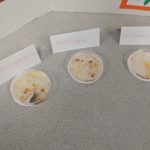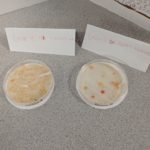Bill writes:
In your excellent recent podcast about finding new calcium-dependent natural antibiotics in soil samples, Vincent, you mentioned that your wife used to collect samples when you were traveling.
It struck me that this is an excellent citizen science activity: travelers would use an app to ask if they were in an interesting location, and could photograph and collect a sample in something like a sandwich bag, and label it with an app-supplied identifier. I would certainly do this in my travels, and I am sure many others would as well.
A quick web search for “citizen science” “soil collection” antibiotics
shows that this has already been thought of, and I think your listeners might be more interested than most in participating. An in-depth examination of the text of the first page of Google results that this may have started only last fall.
Bill
Science guy, on a farm in Flemington NJ.
Sara writes:
Hello,
I’ve been listening to TWiM off and on for a while now, but still can’t quite figure out how I can enter in the drawings for book giveaways, etc. Are you able to provide me a link to such entry, or steps I may take in order to be eligible for entry? I am a current ASM (Student) member.
Thank you,
Sara
Dallas writes:
To Masters of the Microbiological Universe
Your discussion of an hyperthermophilic bacteria that produces H2 was very interesting and a lot closer to my background than most discussions.
The production of H2 by anaerobic fermentation is a very common process and occurs everywhere from a cows gut to landfills. My understanding is that the bacteria that initially breakdown polysaccharides like cellulose producing H2, CO2 and acetate (or lactate and other short chain acids) with the cow using the acetate for energy with the H2 becoming a waste product. However, like most low energetic margin chemical reactions, a buildup of waste products inhibits the reaction rates (Le Chatelier’s Principle from chemistry class) so the H2 concentration needs to be reduced. That is where the archaea methanogens come in that obtain their energy from a small amount of free energy available from producing methane from H2 + CO2 that is the greenhouse gas from cattle (all ruminants). In landfills, along with H2+CO2 methanogens you also have methanogens that convert acetate to methane that keeps the pH from dropping. Methanogenic archaea tend to be very pH sensitive so if the pH drops in an anaerobic fermentation, your methane production stops and you end up with H2 in the gas at high enough concentrations to inhibit the initial fermentation of the carbohydrates and everything shuts down. Having your anaerobic bioreactor in a sewerage plant go “sour” is a problem, but when preserving silage for winter cattle feed where you don’t want all your carbohydrates turned into methane and lost to the atmosphere, having acetate build up and “sour” the mix is good. The genius of man figured out this fermentation, pH, CO2, H2 game a long time ago with all the ways to preserve foods like cabbage for winter.
From a production bioreactor viewpoint, using hyperthermophilic bacteria and other extremophiles for doing your environmental chemistry makes it easy to maintain biosecurity in an open system. The bacteria in the discussed paper is way too hot for most contaminant species that would turn all that H2 and CO2 into methane and their Eh was a bit high for many methanogens. Being hyperthermophilic could allow defined species production of single cell protein and lactate for the animal feeds markets and not have to worry about contamination from some of the real nasty bacteria like Clostridium botulinum.
Many of the excellent papers in this area are from diverse countries around the world. Good science is good science wherever it is produced.
Dallas
PS: sorry about being behind in my listening.
Dallas E. Weaver, Ph.D. , P.E.
Scientific Hatcheries
8152 Evelyn Cr.
Huntington Beach, CA 92646
Cherish writes:
Hello TWIM Hosts,
My name is Cherish Hughey. I’m a 4th grade teacher at Riverside Prep Elementary in Oro Grande, CA. (It’s a really small town along old Route 66)
My students currently completed a science project that I wanted to share with you. After learning about microorganisms, the students were curious where the most germs could be found around our school.
The students picked 5 places to test: a tetherball, the playground equipment, a chair in the nurse’s office, the music room mats they sit on, and the keyboards in the computer lab. The samples were wiped on agar plates and the wait began.
After a week, the students were totally grossed out that the music room mats they sit on had the most growth on their agar plates. The students have requested that the music room mats be replaced or cleaned regularly as a result of their findings. We’re still waiting for the principal’s answer.
I’m trying to inspire future scientists. I hope you enjoyed their project.
I love the show and look forward to listening on my daily commute to school.
Have a great day,
Cherish Hughey



